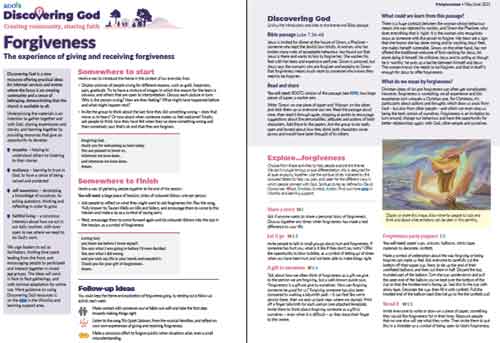The experience of giving and receiving forgiveness
Go to: Introducing Discovering God to find out more about this series of resources.
Download Forgiveness

Click on the image to view a PDF.
If you're printing off the PDF rather than using the full text below you will need the following online resources:
For the Read and Share section you will need Simon and the crying woman.
Somewhere to start
Here’s a way to introduce the theme in the context of our everyday lives.
- Display pictures of people crying for different reasons, such as guilt, happiness, pain, gratitude. Try to have a mixture of images in which the reason for the tears is obvious, and others that are open to interpretation. Discuss each picture in turn: Why is the person crying? How are they feeling? What might have happened before and what might happen next?
- Invite the group to think about the last time they did something wrong – does that move us to tears? Or how about when someone makes us feel welcome? Finally, ask people to think how they have felt when they’ve done something wrong and then somebody says that’s ok and that they are forgiven.
Prayer
Forgiving God,
thank you for welcoming us here today.
You are pleased to know us,
wherever we have been,
and whatever we have done.
Amen.
Somewhere to finish
Here’s a way of gathering people together at the end of the session.
You will need: a large piece of hessian; strips of coloured ribbon, one per person.
- Ask people to reflect on what they might want to ask forgiveness for. Play the song, ‘Fully known’ by Tauren Wells on Hills and Valleys, and encourage them to come to the hessian and make a rip as a symbol of saying sorry.
- Next, encourage them to come forward again and tie coloured ribbons into the rips in the hessian, as a symbol of forgiveness.
Prayer
Loving God,
you knew me before I knew myself.
You saw what I was going to before I’d even decided.
You saw what I did wrongand you took my life in your hands and mended it.
Thank you for your gift of forgiveness.
Amen.
Follow-up ideas
You could keep the theme and exploration of forgiveness going, by sending out a follow-up activity each week:
 |
Make contact with someone you’ve fallen out with and take the first step towards making things right.
|
 |
Listen to the song ‘It’s Quiet Uptown’, from the musical Hamilton, and reflect on your own experiences of giving and receiving forgiveness.
|
 |
Make a conscious effort to forgive quickly when situations arise, even a small misunderstanding.
|
Discovering God
Linking the introductory activities to the theme and Bible passage
Bible passage Luke 7.36-48
Jesus is invited for dinner at the house of Simon, a Pharisee – someone who kept the Jewish law strictly. A woman, who has broken many rules of acceptable behaviour, has found out that Jesus is there and wants to him to forgive her. She washes his feet with her tears and expensive perfume.
Simon is annoyed, but Jesus says the woman’s sins are forgiven and explains to Simon that forgiveness means much more to someone who knows they need to be forgiven.
Read and share
You will need: ROOTS version of the passage (Simon and the crying woman); two large pieces of paper, a marker pen.
Write ‘Simon’ on one piece of paper and ‘Woman’ on the other, and stick them up so everyone can see. Read the passage aloud once, then read it through again, stopping at points to encourage suggestions about the personalities, attitudes and actions of both characters. Add these to the papers. Ask the group to be really open and honest about how they think both characters come across and would have been thought of by others.
What could we learn from this passage?
There is a huge contrast between the woman whose behaviour means she was rejected by society, and Simon the Pharisee, who does everything that is ‘right’. It is the woman who recognises Jesus as someone with the power to forgive. Her tears are a sign that she knows she has done wrong and by washing Jesus’ feet, she makes herself vulnerable. Simon, on the other hand, has not offered the traditional welcome of foot washing for Jesus, let alone doing it himself. He criticises Jesus and by acting as though he is ‘worthy’, he puts up a barrier between himself and Jesus. The woman knows she needs to be forgiven, and that in itself is enough for Jesus to offer forgiveness.
What do we mean by forgiveness?
Christian ideas of sin and forgiveness can often get complicated. However, forgiveness is something we all experience and this experience isn’t uniquely a Christian one. For Christians, it’s particularly about actions and thoughts which draw us away from God – but also from other people – and which can even stop us being the best version of ourselves. Forgiveness is an invitation to turn around, change our behaviour and have the opportunity for better relationships again: with God, other people and ourselves.
Explore...forgiveness
Choose from these activities to help people explore the theme. We don’t include timings or age-differentiation, this is designed for all ages engaging together. Use the spiritual styles indicated by the coloured letters to help you plan, and cater for the different ways in which people connect with God. Spiritual styles (as defined by David Csinos) key: Word, Emotion, Symbol, Action. Find out more.
Share a story W E
Ask if anyone wants to share a personal story of forgiveness. Discuss together any times when forgiveness has made a real difference to your life.
Let it go W E S
Invite people to talk in small groups about hurt and forgiveness. If someone has hurt you, what is it like if they don’t say sorry? Offer the opportunity to blow bubbles, as a symbol of letting go of times when you have been hurt and not been able to make things right.
A gift to ourselves W E A
Talk about how we often think of forgiveness as a gift we give to the person we are forgiving, but a well-known quote says, ‘Forgiveness is a gift we give to ourselves.’ How can forgiving someone be good for us? Forgiving someone has also been compared to walking a labyrinth path – it can feel like we’re almost there, then we end up back near where we started. Print off a finger labyrinth for each person (see attached template). Invite them to think about forgiving someone as a gift to ourselves – even when it is difficult – as they trace their finger to the centre. Display or share this image. Allow time for people to look and think and about what emotions can be seen in this painting.
 |
Display or share this image.
Allow time for people to look
and think about the emotions
that can be seen in this painting.
(Click on the image to view a larger version.) |
Forgiveness party poppers E S
You will need: paper cups, scissors, balloons, sticky tape, materials to decorate, confetti. Make a symbol of celebration about the way forgiving or being forgiven can make us feel. Ask everyone to carefully cut the bottom off their paper cup. Next, to tie up the end of their uninflated balloons and then cut them in half. Discard the top, rounded part of the balloon. Turn the cup upside-down and pull the open end of the balloon you’ve kept over the bottom of the cup so that the knotted end is facing up. Seal this to the cup with sticky tape. Decorate the cup, then fill it with confetti. Pull the knotted end of the balloon back then let go to fire the confetti out!
Shred it W E S
Invite everyone to write or draw on a piece of paper, something they would like forgiveness for in their lives. Reassure people that no one else will see what they write. Then invite them to put this in a shredder as a symbol of being open to God’s forgiveness.